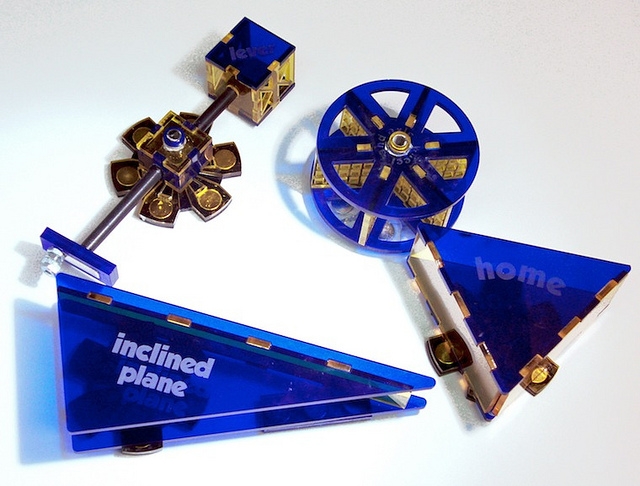
By Amy Yuen
An award-winning interactive display created by Stanford students is rapidly gaining notice for its imaginative approach to teaching children engineering design.
Mechanix is a magnetic computer display that merges interactive educational technology with tangible simple machine components. Children create compound systems by arranging five magnetic pieces—a wheel and axle, lever, pulley, inclined plane, and wedge—on the display to solve various engineering challenges. Once a player creates a successful design, he or she can record it into a digital library by way of a seamless image-detection system behind the display. This allows subsequent children to access a wide variety of challenges and solutions, enabling them to create, tackle, and solve increasingly difficult configurations.
“Traditional science education tends to emphasize abstract formulas at the expense of providing experiences with the actual, underlying phenomena,” says Coram Bryant, a 2010 graduate of Stanford’s Learning, Design and Technology master’s program. His co-creator, Stanford mechanical engineering master’s student Tiffany Tseng, adds, “With Mechanix, we have created a framework for children to learn about physics concepts through hands-on play and exploration.”
Bryant and Tseng created Mechanix this past May as their final project for Professor Paulo Blikstein’s Beyond Bits and Atoms class (EDUC 236x/CS402), a Stanford course for tech novices to “get their hands dirty” designing educational software, toolkits, toys, and tangible user interfaces. In July, just two months into the development of Mechanix, Bryant and Tseng beat out submissions from universities and companies from around the world—some of which had been developed by research groups over several years—to win the prize for innovation in the 2010 SIGGRAPH Disney Learning Challenge. The competition, sponsored by Disney Research with the goal of finding new and creative ways to use technology to make learning fun for children, awarded Mechanix for demonstrating “a fundamental change to the way learning is enabled through transformative uses of digital media and interactivity.”
“Technology design for education is too focused on screen-only interaction -- we’re forgetting that children like to play and learn with real, physical objects,” says Paulo Blikstein, faculty advisor of the project and assistant professor of education and (by courtesy) computer science at Stanford. “Mechanix brings complex engineering ideas to students in a very motivating way in early elementary school, before many students become disengaged with traditional mathematics and science. Imagine if we get 10 or 20% of them hooked on engineering?”
This January, Bryant and Tseng will present Mechanix at the 2011 Tangible, Embedded and Embodied Interaction (TEI) Conference in Portugal. TEI draws researchers from around the world who specialize in human computer interaction theory and design, specifically as they pertain to tangible user interfaces.
In the meantime, Bryant and Tseng are finalizing their design and implementation of SLATE (System for Learning and Assessment through Tangible Exploration), a generic framework that will support a variety of interactive toolkits in addition to Mechanix. They are currently planning extensions for musical composition and optics as well as support for children and developers to create their own toolkits and games for use with the SLATE framework.
Watch a video to see how Mechanix works. To learn more about Mechanix and SLATE, visit http://slate-learning.com.
Subscribe to our monthly newsletter.